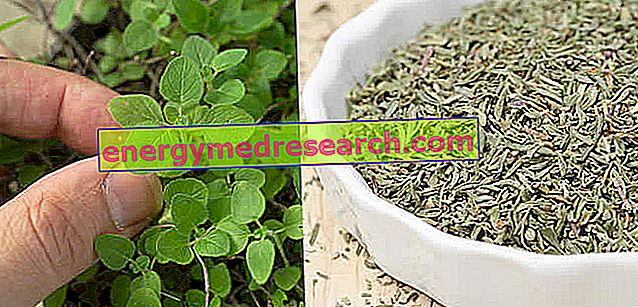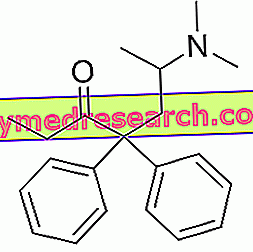Generality and Etymology
Oregano is a herbaceous plant that can be placed among the aromatic herbs; also known as common oregano, it is identified by the binomial nomenclature Origanum vulgare .
The vegetable most closely related to oregano is marjoram or "garden oregano", which belongs to the same genus ( Origanum ) but to a different species ( Origanum majorana ).

Oregano or Marjoram?
The two aromatics have almost overlapping medicinal properties; so much so that, in France, oregano is also called "marjolaine batarde" or "bastard marjoram". For the same reason, many kitchen technicians unify them under the same wording, linking their gastronomic applications.
Despite the close resemblance, oregano lends itself to the combination with almost all foods, including meat (the famous condiment typical of southern Italy for grilled meat); on the contrary, marjoram makes it mainly in fish recipes. Therefore, whoever confuses oregano with marjoram cannot be considered a cooking expert.
The word "oregano" comes from the ancient Greek "origanon", which can be translated as "having fun on the mountain", composed of "oros" or "mountain", and "ganos"; means: "appearance of those who have fun".
Gastronomic Applications, Phytotherapy and Nutritional Properties
Oregano is typical of Italian and Portuguese cuisine, while marjoram is most used in France.
In the Bel Paese, oregano is widely used in sauces, especially in condiments for pasta dishes (eg tomato sauce), and goes perfectly with many other aromatic dishes (mainly basil and thyme).
Oregano based recipes
| Nutritional composition for 100g of "Fresh Oregano" | |||||||||||||||||||||||||||||||||||||||||||||||||||||||||||||||||||||||||||||||||||||||||||||||
 | |||||||||||||||||||||||||||||||||||||||||||||||||||||||||||||||||||||||||||||||||||||||||||||||
Nutritional values (per 100 g of edible portion) | |||||||||||||||||||||||||||||||||||||||||||||||||||||||||||||||||||||||||||||||||||||||||||||||
| |||||||||||||||||||||||||||||||||||||||||||||||||||||||||||||||||||||||||||||||||||||||||||||||
Oregano, like marjoram, has discrete antibacterial properties.
Whole leaves are used from oregano but - in case of colds, flu and poor digestion - it can be used as an infusion for herbal teas.
In fact, the essential oil of oregano is considered a powerful antiseptic, indicated for any type of infection of the upper airways and oral cavity. It can also be used as a natural mouthwash to disinfect the mouth and as a teeth whitener.
The essential oil of oregano is also a remedy against spasmodic pains and, according to what they say, is useful against fatigue and stress (questionable).
If considered as a food, oregano is very rich in nutrients (especially vitamins and minerals); however, it must be remembered that this is a product whose use is "quantitatively" marginal, not so much for the consumption frequencies as for the portion used (equivalent to a few grams). Ultimately, despite the excellent chemical characteristics, oregano cannot have a significant impact on the diet.
Oregano is a plant-based food that belongs to the group of aromatic herbs. Fresh has a moderate energy intake, characterized by the prevalence of carbohydrates, followed by lipids and finally by proteins. The glucides tend to be simple, the polyunsaturated fatty acids and the peptides with low biological value. Oregano does not contain cholesterol and provides a very high amount of fiber.
As far as mineral salts are concerned, oregano stretches due to its iron content (probably not very bioavailable), calcium and potassium; observing the vitamin profile, one can appreciate excellent concentrations of niacin (vit PP), retinol equivalent (pro vit A), tocopherols (vit E) and ascorbic acid (vit C).
The average portion of oregano is subjective, but rarely higher than 5g (3kcal).
Botanical, Cultivation and History notes
The oregano plants reach a size between 30 and 80cm in height. The stems are red in color, have a square section and are covered with down; the leaves have a rounded shape and green color. The flowers, grouped in small inflorescences, appear pink or purple.
Oregano can be grown by spreading its stolons (axillary branches that develop roots) and seeds. The plants must be spaced 30cm from each other; they need a calcareous, light and draining soil. The position should also be shaded, not too exposed to the wind. We remember that the oregano is a spontaneous and rustic plant, therefore, these expedients interest above all the cultivations in environments / hostile or not native climates.
In organic farming, the oregano macerate helps fight the "Balanino della Nocciola" ( Curculio nucum ) and other Curculionidae .
Originally from Europe, oregano has also been exported to the Middle East, where it has been known and recognized since ancient times for its intense taste and medicinal properties. In the past, oregano was known for two characteristics: its therapeutic role and as a filter of love.



